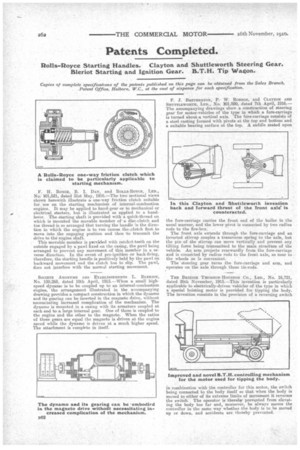Patents Completed.
Page 22

If you've noticed an error in this article please click here to report it so we can fix it.
Rolls-Royce Starting Handles. Clayton and Shuttleworth Steering Gear. Bleriot starting and Ignition Gear. B.T.H. Tip Wagon.
Copies of complete specifications of the patents published on this page can be obtained from the Sales Branch, Patent Office, Holborn, W.C., at the cost of sixpence for each specification.
F. H. ROYCE, B. I. Day, and ROLLS-ROYCE, LTD., No. 101,521, dated 31st May, 1916.—The two sectional views shown herewith illustrate a one-way friction clutch suitable for use on the starting mechanism of internal-combustion engines. It may be applied to hand-gear or to mechanical or electrical starters, but is illustrated as applied to a handlever. The starting shaft is provided with a quick-thread on which is mounted the movable member of-a disc-clutch and the thread is so arranged that turning the handle in the direction in which the engine is to run causes the ,clutch first to move into the engaging position and then -to transmit the drive to the engine shaft.
This movable member is provided with ratchet-teeth on the outside engaged by a pawl fixed on the casing, the pawl being arranged to prevent any movement of this member in a reverse direction. In the event of pre-ignition or back-firing, therefore, the starting handle is positively held by the pawl on backward movement and the clutch has to slip. The pawl, does not interfere with the normal starting movement.
SOCIETE ANONYM: DES ETABLISSEMENTS L. BLERIOT, No. 100,268, dated 10th April, 1915.—When a small highspeed dynamo is to be coupled up to an internal-combustion engine, the arrangement illustrated in the accompanying drawing provides a compact construction in which the dynamo and its gearing can be inserted in the magneto drive, without necessitating increased complication of the mechanism. The dynamo is mounted in a casing with its armature coupled at each end to a large internal gear. One of theso is coupled to the engine and the other to the magneto. When the ratios of these gears are equal the magneto is driven at the engine speed while the dynamo is driven at a much higher speed. The attachment is complete in itself. F. J. BEETHERTON, P. W. ROBSON, and CLAYTON AND SHIIITLEWORTH, LTD., No. 101,590, dated 7th April, 1916.— The accompanying drawings show a construction of steering gear for motor-vehicles of the type in which a fore-carriage is turned about.a vertical axis. The fore-carriage consists of a steel casting formed with pivots at the tap and bottom and a suitable bearing surface at the top. A saddle seated upon
the fore-carriage carries the front end of the boiler in the usual manner, and the lower pivot is connected by two radius rods to the fire-box.
The front axle extends through the fore-carriage and an inverted stirrup couples a transverse spring to the axle, but the pin of the stirrup can move vertically and prevent any tilting force being transmitted to the main structure of the vehicle. An arm projects rearwardly from the fore-carriage and is connected by radius rods to the front axle, as near to the wheels as is convenient.
The steering gear turns the fore-carriage and arm, and operates on the axle through these tie-rods.
THE BRITISH THOXISON-HOUSTON CO., LTD., No. 16,721, dated 26th November, 1915.—This invention is particularly applicable to electrically-driven vehicles of the type in which a special hoisting motor is provided for tipping the body. The invention consists in the provision of a reversing switch in combination with the controller for this motor, the switch being connected to the body itself so that when the body is moved to either of its extreme limits of movement it reverses the 'mita. The operator is thereby prevented from elevating the body too far and, moreover, he always moves the controller in the same way whether the body is to be moved up or down, and accidents are thereby prevented.






















